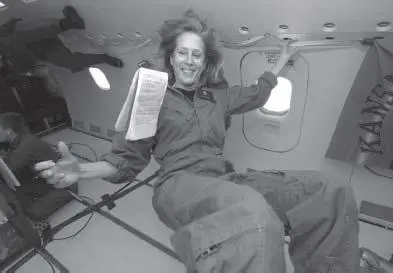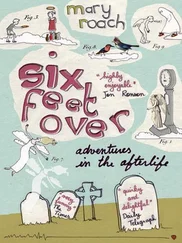Von Beckh quickly moved on from turtles to Argentinean pilots. Under the section heading “Experiments with Human Subjects”—a heading that, were I a doctor previously employed by Nazi Germany, I might have rephrased—von Beckh reports on the efforts of the pilots to mark X ’s inside small boxes during regular and weightless flight. During weightlessness, many of the letters strayed from the boxes, indicating that pilots might experience difficulties maneuvering their planes and doing crossword puzzles during air battles.
The following year, von Beckh was recruited by the Aeromedical Research Laboratory at Holloman Air Force Base—home of Dave Simons and Project Albert. Simons was keen to continue his zero-gravity research using the newfangled parabolic flight technique. All he needed was a willing pilot. Only one man volunteered. Joe Kittinger “made a career” out of volunteering. “You can’t get any real fun things unless you volunteer,” says Kittinger in an oral history on file at the New Mexico Museum of Space History. (Kittinger has a unique sense of fun. In 1960, he volunteered to make a parachute jump into the near-airless void 19 miles above the Earth, to test survival equipment for extremely high-altitude bailouts. More on this in chapter 13.)
Kittinger would take the plane up at a 45-degree angle, and then arc it over and plunge back down, all the while watching a golf ball suspended on a string from the cockpit ceiling. “That was our instrumentation!” Kittinger told me. When the plane achieved zero gravity, the golf ball started floating. So did Kittinger, of course, but he was strapped in his seat. Meanwhile, back behind the cockpit, a Salvador Dali photo had come to life. Von Beckh and Simons were studying, among other things, cats’ ability to right themselves in zero gravity. “The guys would take them and just let them float,” recalled Kittinger. “Here would come a cat and I would push the cat back. A couple of times we had a monkey come floating up to the cockpit. And I would take the monkey and I would push it back.”
When it became clear that a few seconds of weightlessness was more entertaining than it was troublesome, the aerospace medicine crowd began to apply their boundless nervous energy to the scenario of longer-duration missions. Would an astronaut on a three-or four-day orbit of Earth or a trip to the moon be able to eat, or did he need gravity to help the food along? How would he drink water? Does a straw work in zero gravity? Late in 1958, three captains at the U.S. Air Force School of Aviation Medicine at Randolph Air Force Base in Texas commandeered an F-94C fighter plane and fifteen volunteers and undertook a project to answer these simple questions. Though they were phrased less simply for the journal paper, which came out under the title “Physiologic Response to Subgravity: Mechanics of Nourishment and Deglutition of Solids and Liquids.”
The captains were not reassured by what they found. New and never-before-encountered dangers presented themselves. Water in a cup became “an amoeboid mass” that would levitate from the cup and “envelop” the face. “The fluid flowed into the…sinuses as the subjects attempted to breathe. Choking—virtually a sense of drowning—was a common occurrence.” Eating was deemed equally perilous. “A number of subjects reported that pieces of food hung suspended in the oropharynx and several reported that bits of food floated up over the soft palate into the nasal passages.” Chewed food, they claimed, was drifting up the esophagus into the mouth, where it “caused the subjects to vomit and feel ill.” I would have assumed that the vomiting was due to the plane’s insane trajectory, or perhaps something having to do with zero gravity’s effect on the vestibular system, but the researchers stuck to their loopy guns and coined a new, utterly nonexistent phenomenon: Weightless Flight Regurgitation Phenomenon.
Fast-forward five months. The three captains are now majors. They commandeer yet another F-94C and begin “Physiologic Response to Subgravity: Initiation of Micturition.” The concern was legitimate. If you counteract the pull of gravity, will the bladder still empty correctly? Based on their zero-gravity experiences with glasses of water (“exceedingly messy”), the researchers knew better than to have the men urinate into an open container. Using scrap hosing from oxygen masks and small weather balloons, they fashioned enclosed urine receptacles. To make sure everyone needed to go, the subjects were, with characteristic Air Force zeal, told to drink eight glasses of water over the course of the two hours leading up to flight time. Severe discomfort resulted, such that several of the men had to visit the head well before the plane took off. In the end, everything worked fine, and the urine flowed normally.
Kittinger has a name for the researchers: weenies. “There were scientific papers put out all over the place by the experts that said that [zero gravity] was going to be the limit to putting man into space,” says Kittinger in his oral history. “And I just sat there and laughed my butt off, because I loved it! I thoroughly enjoyed it.”
You can’t really blame the weenies. You have to put their concerns in the context of the times. Space and zero gravity were uncharted territory where none of the familiar rules could be assumed to apply. Over the course of history, the same sort of anxiety has appeared every time a newer, faster form of transport has come along. “When technical perfection of the steam engine made the development of railways possible, scientists were afraid that the velocity of the trains would exert harmful effects upon the human body.” The quote comes from an aviation medicine text published in 1943. (Locomotives at that time could not exceed fifteen miles per hour.) In the early 1950s, as commercial flights became available, doctors feared that flying might harm the heart and adversely affect the circulation. When a Dr. John Marbarger showed that it did not, United Airlines gratefully awarded him its Arnold D. Tuttle Award.
Parabolic flights are still being flown by space agencies, but these days it’s not human beings they’re testing—it’s equipment. Every time NASA develops a new piece of hardware—be it a pump or a heating element or a toilet—someone has to haul it up on a plane out of Ellington Field near Houston to see what sort of problems might develop in zero gravity. Twice a year, something even more problematic gets hauled up there: college students and journalists.
5. UNSTOWED
Escaping Gravity on Board NASA’s C-9

If you stumbled onto Building 993 at Ellington Field airport, you would have to stop and wonder about the things inside. The sign on the front is as evocative and preposterous as the engraved brass one that says Ministry of Silly Walks in the Monty Python sketch of the same name. This sign says REDUCED GRAVITY OFFICE. I know what is in there, but even so, I have to stand for a moment and indulge my imagination, through which coffeepots are floating and secretaries drift here and there like paper airplanes. Or better still, an organization devoted to the taking of absolutely nothing seriously.
The real Reduced Gravity Office oversees a program whereby college and high school students compete for the chance to carry out zero-gravity research projects during a parabolic flight on a McDonnell Douglas C-9 military transport jet. [17] Some months after I visited, the flights were outsourced to the Zero G Corporation, which uses a 727. Most people just call the plane the Vomit Comet. Though NASA would like them to stop. They asked us to refer to it as the Weightless Wonder. Which pretty much makes you vomit.
It is run by NASA with, if anything, an excess of gravity.
Читать дальше













